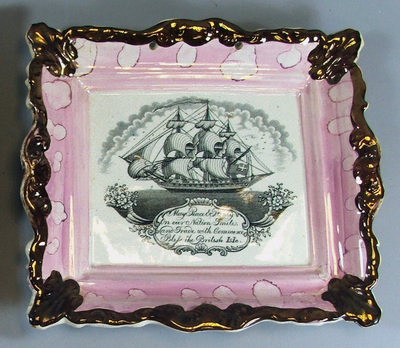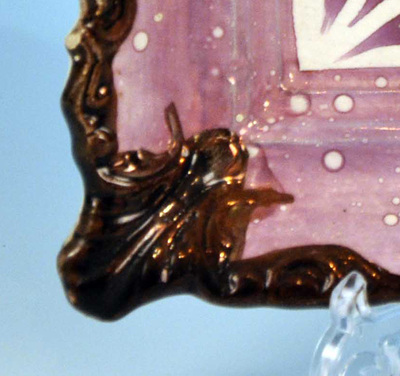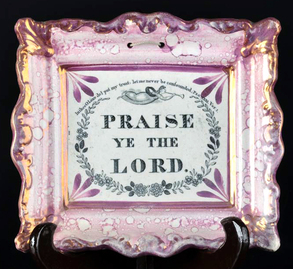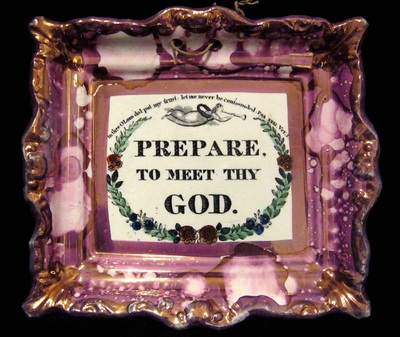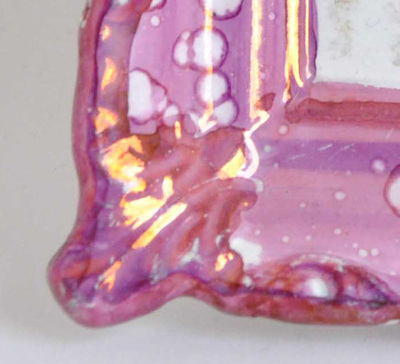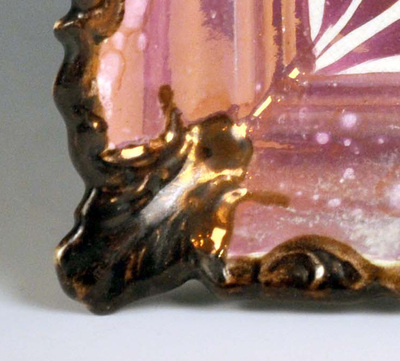|
6/22/2014 0 Comments More on the ship transfersFirst of all, thanks to Ian Holmes and Norman Lowe for their suggestions and photos. I've been thinking again about the transition between the golden age of transfer-printed plaques of the 1840s and 50s, to the mass-production era of the 1860s and beyond. It's not a perfect analogy, but think about the way that novels are published. When a book is new and in vogue, it is released in a hardback edition of a few thousand: expensive to print, with a quality binding, which the publisher can charge a premium for. The market for hardbacks is relatively small, so when the initial excitement surrounding the book is over, it has to compete in a mass market, and the publisher releases it as a cheap paperback in editions of tens or even hundreds of thousands. Now think about the Moore ship plaques of the 1850s: topical, lightly potted, carefully decorated, produced in small numbers... You get the picture. A similar shift in strategy might explain why there are so many more brown-bordered ship plaques than early Moore-impressed examples. By the 1860s pink lustre was becoming old fashioned - it had been around for decades. There was stiff price competition from the more technologically advanced Staffordshire potteries. The advancement of railway networks meant that Staffordshire factories could compete in the same local market. It's no coincidence that around this time (1865) the Garrison Pottery folded after a long period of decline. The Galloway and Atkinson partnership, at the Albion Pottery on Tyneside, barely lasted a year (1864). It was a hard time for North Eastern potters. Baker reports that Moore's too, after a change of ownership in 1861, had to reinvent itself. A manager called Ralph Seddon from Staffordshire was appointed, and 'on his advice the works were largely rebuilt and equipped with modern machinery'. Between 1866 and 1872 the pottery was reported to be the largest on Wearside. Operating at full capacity, Moore's could have employed up to 250 hands, although was reported to have 180 during this period, whereas Scott's employed about 150 (Baker). It was during Moore's period of expansion that the brown-bordered plaques were made in huge numbers. So why is generally assumed they were made by Scott? Isn't it equally possible that the ship plaques continued to be made by Moore? The main argument against this is that the transfers frequently appear on Scott bowls and jugs. But as I never tire of repeating, records show that Scott supplied Moore with plain earthenware for decoration (I've asked the Sunderland Museum if these records are dated, but as yet have not heard anything). The other argument is that the 1860s' brown-bordered plaques look nothing like marked Moore plaques. The late brown-bordered plaques (below right) do, however, have a more than passing resemblance to earlier plaques attributed to Scott (below left). The earlier plaques are, however, slightly smaller and more finely potted. The plaque below, recently listed on eBay, changed the way I'd been thinking. So what's so special about it? Well firstly, the transfer originated around 1847, and belongs to the groups of Moore transfers listed in my last-but-one blog post. Secondly, it has a printed Moore mark (below right). Thirdly, it has copper lustre borders - almost brown - rather than the pink borders we'd generally associate with Moore. Fourthly, the lustre is a deep purple, like that found on the brown-bordered plaques. It appears to be, however, from the standard Moore rectangular mould (smaller than the brown-bordered plaques). I think this is a game changer, and shows that Moore could just have easily made the brown-bordered plaques as Scott. It is the nearest thing we have to a marked prototype. Incidentally, Ian Holmes points out that he also has a Moore Bottle plaque with copper lustre borders and purple lustre (below). I also remembered on Ian Sharp's site, a plaque with unusual blue borders attributed by him to Moore. Ian notes that the 'Success to the Fleece' transfer appears on earlier Moore items. I would have loved to have found an image of one, but the best I could come up with was the bowl below right, which the auction catalogue describes as 'signed Moore & Co, verses including Success to the Fleece and Waverley designs'. You can just make out the edge of the transfer to the right of the photo (click to enlarge). This is important in as much as the 'Fleece' transfer, like The Bottle above, appears to have been used exclusively by Moore. The plaque below is apparently from the same mould as the ship plaques with brown borders. But let's not get too carried away by the idea that blue borders always come with Moore transfers. Ian Holmes has two plaques with similar blue borders. The left plaque below has the Moore & Co 'Praise Ye' (plate 4) transfer, but the right plaque has the Scott-attributed (plate 3) transfer. Incidentally, the brown-bordered plaques would have started with a blue edges like this. When the pink lustre is painted over them, the blue turns to copper. You can see this in the centre detail above. Although the plaques below aren't a true pair, it is hard to imagine that they weren't decorated at the same location. So where does this leave us in terms of the ship transfers? I set out three possibilities at the end of my last-but-one post, that sometime around 1860 either:
The ship transfer plates moved to Scott This is possible, but I haven't found any real evidence for it yet. If Scott held the transfer plates, what was Moore's part in this division of labour? There's no record I'm aware of that Moore sent earthenware to Scott for decoration; records show movement of pottery in the other direction. But, to throw in a cliche, perhaps there's no smoke without fire. The received wisdom that Scott made the brown-bordered ship plaques must have some basis in fact for the idea to have established such a strong hold. The pottery was big enough to have produced plaques in large numbers, and also went through a period of modernisation (although it is less clear from Baker when). Moore decorated plain earthenware for Scott with ship transfers This seems logical at present. But a clearer idea of the dates that Scott supplied Moore with earthenware would need to be established. We know that by the mid 1860s, Moore's was the larger pottery, so we might expect it to have had the additional capacity to cope with decorating Scott's wares. The plaques above show that Moore was decorating objects in similar style to the brown-bordered plaques as early as the 1850s. And, looking back at the late group 1 'Scott' transfers in my previous post, the plaques that Scott appears to have been making in the 1860s were of a higher quality than the brown-bordered plaques. Although it is possible that Scott made both quality wares and cheaper wares to feed two different markets (this might account for why the transfer plates of the two groups remained separate). The ship transfer plates moved to Sheepfolds, who decorated wares for both Moore and Scott with ship transfers, while turning out glass rolling pins on the side This is Norman Lowe's theory, and why not? We know that Sheepfolds made glass rolling pins, and there are plentiful examples of glass rolling pins with the ship transfers. However, some of the other transfers that appear on the rolling pins, 'Love and be happy' for instance, are more closely associated with the orange-lustre period of the 1870s. I think that Sheepfolds is a strong contender to have decorated the later, orange ship plaques from both Moore and Scott. But as for the brown-bordered plaques of the 1860s, I'm not so sure. So as ever there's no clear answer. A wider study of Scott- and Moore-marked wares might add to the debate. P.S.Look at the corner details of the three plaques below. The 1850s' Scott-attributed plaque (left) has a transfer that also appears on brown-bordered ship plaques (right). However, the plaque with a Moore printed mark (centre) has an almost identical corner detail to the brown-bordered plaque. Below is another transitional item with a Moore plaque form, transfer, and typical pink lustre borders, but with the three lustre strokes in each corner around the transfer that often appear on later brown-bordered plaques. All this got me thinking. What if the plaques with Sunderland plate 5 'Prepare' transfers were all Moore? The plaques below would nicely demonstrate the transition of decoration, from the pink lustre of the 1850s, through purple lustre, to the brown-bordered plaque of the 1860s. Perhaps the watchword should be, 'Render unto Moore the things that are Moore's, and unto Scott the things that are Scott's'.
0 Comments
Leave a Reply. |
AuthorStephen Smith lives in London, and is always happy to hear from other collectors. If you have an interesting collection of plaques, and are based in the UK, he will photograph them for you. Free advice given regarding selling and dispersal of a collection, or to those wishing to start one. Just get in touch... Archives
February 2022
AcknowledgementsThis website is indebted to collectors, dealers and enthusiasts who have shared their knowledge or photos. In particular: Ian Holmes, Stephen Duckworth, Dick Henrywood, Norman Lowe, Keith Lovell, Donald H Ryan, Harold Crowder, Jack and Joyce Cockerill, Myrna Schkolne, Elinor Penna, Ian Sharp, Shauna Gregg at the Sunderland Museum, Keith Bell, Martyn Edgell, and Liz Denton.
|


